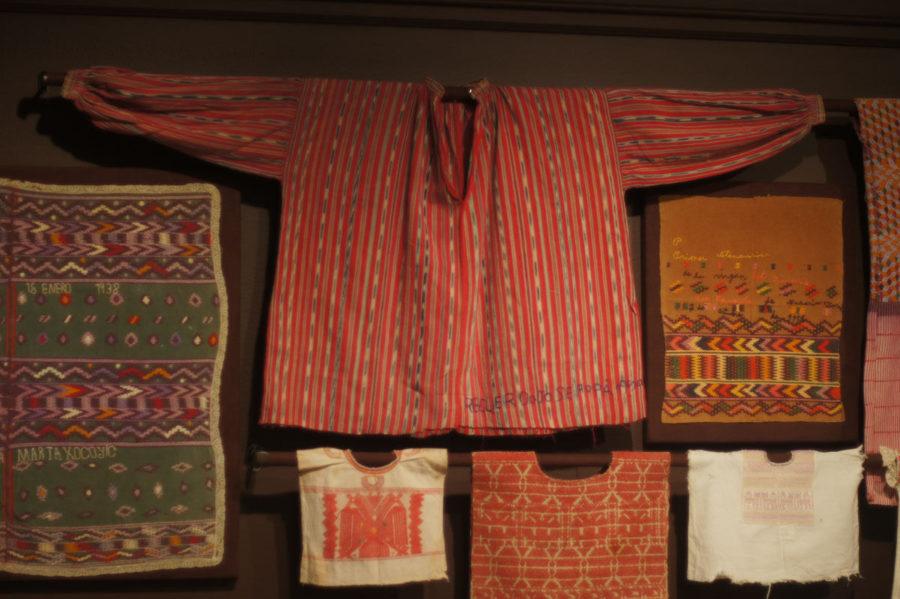New art exhibit at Spurlock
September 16, 2014
The exhibition “Artists of the loom: Maya Weavers of Guatemala,” opening Tuesday at the Spurlock Museum, tells its story through the narratives of hand-woven textiles. The descendants of Mayan people in Guatemala have worn these colorful embroidered garments, called “Huipiles,” as a century old traditional insignia of identity.
Hand-sewn images of quetzals, jaguars, maize stalks, ancient gods and folktale narratives are some of the mythical creatures and ancient motifs that have been translated into the bright threads of more than 90 weavings from 82 highland towns. Many of these designs are tales of ancient stories passed down through generations within isolated communities, while some are believed to possess supernatural powers.
For example, when one dons the Huipil from Chichicastenango, Guatemala, on which the central head hole signifies the sun, the wearer is symbolically placed in the very center of the universe.
“The significance of the imagery is reflective of long standing and important beliefs about the natural world,” said Tandy Lacy, director of education for the museum and coordinator of the exhibit. “I think that any time a people begin to better understand what incredible diversity there is in cultures around the world, the more respect that they might have for the people who carry on those traditions.”
The collection is one that was donated by Gerard Lopez and his late wife Margaret “Peg” Kieffer in 2008 from a 30 year Ph.D. research endeavor, as the couple set out to explore the significance of these Mayan weavings to their cultural identity. They arrived at the height of the Guatemalan Civil war in 1972, and these so called “artists of the loom” were plying their trade at a time when cultural identity was crucial.
Get The Daily Illini in your inbox!
The three-decade civil war, which ran from 1960 to 1996, saw the Guatemalan government pinned up against left-wing guerillas fighting for social, economic and religious changes in the country. One of the greatest casualties of this 36-year war was the weaving culture, as a lot of the fighting was done in rural areas with high concentrations of Mayan people. It was a deadly war that saw a scorched-earth campaign by the Guatemalan military, resulting in more than 100,000 casualties and 400,000 missing people, as they intended to annihilate Indian villages who were sympathetic toward guerillas.
One of the factors that helped identify groups of guerilla-sympathizing native Mayan groups were Huipil designs that were distinct to certain villages and towns. Because many of the government soldiers also came from villages with similar, case-special emblems and patterns on their Huipils and clothing, they were able to identify guerilla-sympathizing groups by their Huipil patterns. The brutality of war also displaced thousands of Mayans from ancestral lands, forever contaminating the weaving culture that was pure before the war had started.
As a result, some villages lost their weaving cultures in the aftermath of the war.
“In this (community) … the Cofradilla died out. The weavers stopped doing this kind of intricate Cofradilla wear and only recently have those weavers been interested in bringing that tradition back, but because they have lost the skill behind the weaving, they’re having to go to other communities to have the weaving done and brought back in. In other instances people sort of stopped weaving what their community was identified by and are now just beginning to weave it again,” Lacy said.
In recent decades, traditional Huipils have become less of a form of daily dress and more of a badge, as the traditional wear has often been relegated to tourism and special occasions. These weavings have been packed into the suitcases of tourists, which has been an important aspect in reviving the art of weaving in the years since the civil war.
Emilio Cabrera, freshman in DGS, got the opportunity to see the Huipils first hand this past summer on a two-week service trip to Guatemala. While on the trip, he served as a farmhand for rural families who taught him about their weaving culture.
“I was taken aback by how intricate the traditional Mayan weavings wear because they were so intricate and colorful,” Cabrera said. “They were very proud of their weaving culture. It was basically a lifestyle. Everyone did it, even the men. It wasn’t just the women’s job. Men especially knew how to basket weave and weave clothing … these weavings were extremely important to not only their culture, but also their lifestyle, because that’s where they made their money off of.”
The exhibition runs from Tuesday to Jan. 15 at the Spurlock Museum on the first floor, and Lacy hopes it will educate the local community about Guatemalan weaving culture.
“I would hope that they would have an increased appreciation for the artistry of the work that they see and begin to understand a few things that have to do with the fabric of life in Guatemala.”
Eliseo can be reached at [email protected].







